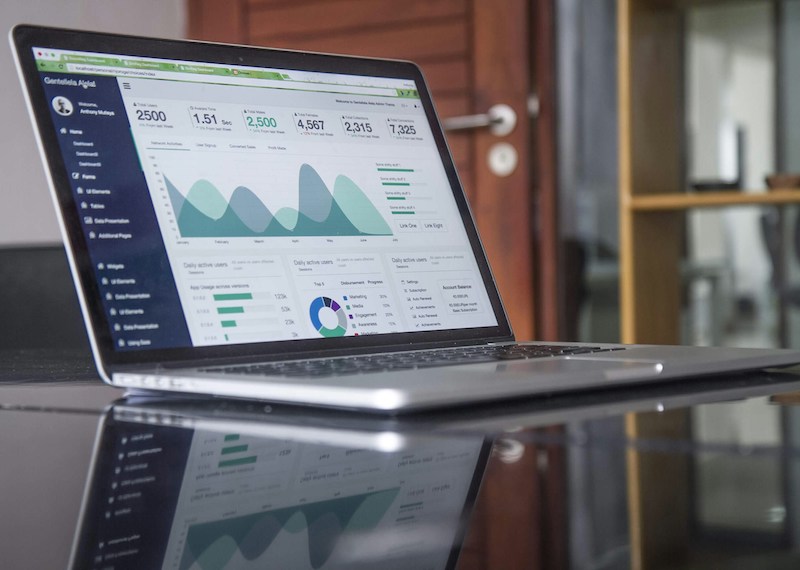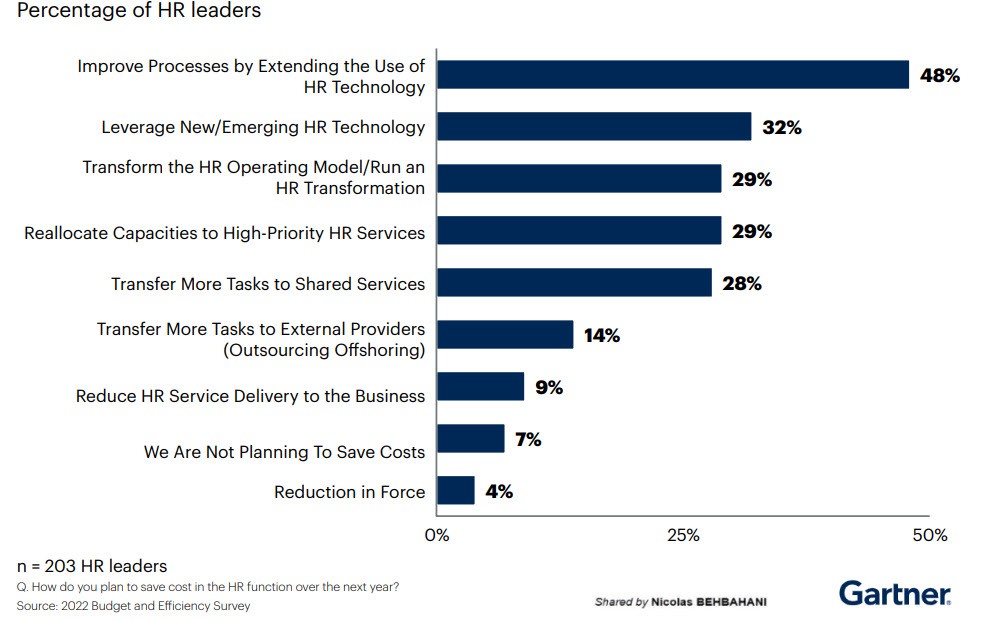HR data analytics: Unlocking insights for workforce success
The global HR analytics market was valued at US$2.96 billion in 2022, with 14.8% growth expected by 2030. Companies are racing to harness HR data analytics, transforming workforce insights into strategic advantages. Discover how this powerful tool is revolutionizing human resources and driving business success.
- Author
 Jesse Liszka
Jesse Liszka

Understanding HR data analytics
HR analytics goes by a couple of different names, including workforce analytics or people analytics. It’s the practice of gathering, studying, and applying HR data to improve business performance by making informed decisions when hiring.
These improvements can include anything from delivering a better employee experience to improving metrics such as revenue per employee and retention rates, all the way to enabling greater future outcomes for the organization as a whole.
A lot of the data you use will come from your company’s Human Resources Information System (HRIS). After all, what is HRIS good for if you don’t use that rich data to make strategic decisions and build a more productive workforce?
This approach aims to enable workforce optimization via predictive analytics and data-driven decision-making. When you properly understand your people and their workloads, it’s easier to predict behavioral trends and how they’ll react to changes in circumstance.
It’s also important to distinguish between HR analytics and HR reporting. Whereas analytics is the collection and study of data, reporting means compiling that data efficiently, with actionable insights clearly on display.
The applications of HR analytics
Since people influence just about every aspect of your organization, the same obviously goes for the potential impact of HR data analytics. Here are some of the major ways HR insights can improve business outcomes and employee experience.
Talent acquisition and retention
Two priorities for any business are to hire and retain talent. So, your initial focus should be on quality of hires and employee morale. First, you need to be engaging and promising enough, with a unique company culture that fosters workforce diversity, to turn the heads of high-value candidates.
Second, you need to support and develop your new hires so employee satisfaction goes through the roof. Fortunately, HR data analytics helps you more effectively put the “human” into human resources.
Its solid analytics capabilities provide a firm basis for HR policies and informed decisions, serving as a kind of scam and fraud alert system—helping prevent missteps rather than relying on guesswork about what your people want.
This reduces employee turnover rates, making people more likely to stick around long-term. Let’s say you have a lot of employees with children, causing a high number of unplanned personal days due to emergencies. Following this “people analytics” approach, you could discover that your staff would benefit from hybrid and flexible arrangements.
HR data is also rich in descriptive analytics, allowing you to identify recruitment needs, like particular skills gaps in your business. This means you can focus recruitment resources on the most essential areas, boosting the business impact of your entire HR process.
Performance management
Team leaders must inspire trust and productivity in their staff. However, HR data analytics also play a key role in managing and enabling employee performance. Using performance management analytics allows you to identify your top performers for promotion or other employee development opportunities.
A data-driven approach also allows you to set more relevant and reasonable performance metrics, KPIs, and goals for your employees – from junior staff to business leaders. The level of performance you need to sustain business growth is strictly linked to your percentage of employees and can be balanced against things like revenue per employee and workplace upkeep costs.
The right HR data can also be used to grow employee engagement and productivity which may enable you to improve certain business processes. This can be done by identifying blockers like an unproductive work environment, or engaging practices like development opportunities and employee recognition, which contribute positively to work culture.
Workforce planning and optimization
Human resource management is not just about hiring and developing talent. It can also play a crucial role in strategic decision making and boosting the business based on actionable insights. One of the areas it can help with is workforce planning.
Workforce planning involves managing the present, but also preparing for the future, thanks to things like predictive HR analytics, statistical analysis, and prescriptive analytics. You need to be able to account for an organization’s needs ahead of time.
In other words, you need proper succession planning. What happens when key personnel quit or retire? Don't simply focus on the exit interview, but also start thinking about crucial aspects, such as: Will you hire externally, or promote from within?
Just remember that, if it’s the former, new hires will need things like benefits administration by HR and other forms of employee investment. On the other hand, internal candidates may require additional training to step into a new role.
This data-based approach even makes it easier to plan workforce allocation by reviewing data from prior work cycles. In a graphic design firm, for example, people might work individually on their solo projects while meeting on a regular basis to fit them together into one multi-media presentation with business managers.
Benefits of implementing HR analytics
We’ve established some of the most important uses for HR data analytics, but what impact do they actually have on your talent management processes?
Let’s break down the benefits of implementing and applying HR analytics in your organization.
Data-driven decision-making for strategic HR initiatives
According to a recent literature review: These strategies enable HR professionals to acquire and evaluate data to enhance organizational performance and the firm’s bottom line.2
“To have a strategic impact on their organizations, HR professionals must use evidence-based practices and HR data analytics. These strategies enable HR professionals to acquire and evaluate data to enhance organizational performance and the firm’s bottom line.”

Photo by Carlos Muza on Unsplash
Simply put, solid data allows business leaders to make decisions based on facts rather than gut instinct or guesswork. However, the review correctly points out that data-driven analytics are a way of supplementing human insights, not replacing them. Strategic decision-making remains the remit of business managers and leaders.
Improved employee engagement and retention
While greater productivity might be the biggest priority on your list of business goals, it’s not an unlimited workforce that lets you achieve this; it's employee engagement. Engagement is the level of someone’s attachment and commitment to their role, and employer, across the whole employee life cycle. High engagement typically means greater focus and more loyalty to the organization.
In the words of Marlee contributor Jessica Orika:
“A well-defined talent acquisition strategy sources potential employees who have the right skills and align with your company's culture and values. When top performers feel they belong and share the company's vision, they are more likely to stay.”
When you fail to support people like this, they become flight-risk employees. So, encourage engagement and listen to your people to keep employee attrition rates low.
Looking at attrition trends is crucial for smaller employers. About 8 in 10 of 1500 surveyed small companies stated that they find it hard to hire new talent, while over 45% can’t hang onto existing staff.
Enhanced operational efficiency and cost savings
Combining HR data analytics with information from other areas of your company offers a comprehensive view of your business’s workflow. This makes it easier to identify high-turnover roles, efficiency obstacles, and areas for improvement.
For instance, you might notice that your call center workers are pulling a lot of overtime to keep up with customer demand. The upfront costs of implementing call center automation technology might be off-putting. But, if it cuts customer wait times and streamlines operations, then it’s arguably worth it.

Most Common HR Cost Saving Measures Planned for 2023. Source: Cost savings in HR must always come with investment in Talent
Of course, savings in other areas are great. Unfortunately, you’ve got to measure them against the cost of HR analytics investment. That said, 48% of HR leaders surveyed by Gartner in 2023 planned to save money and improve processes by extending the use of HR technology.
Better alignment of HR strategies with overall business objectives
The last thing you want when running a business is to have different departments working against each other. Poorly thought-out HR strategies clog comms channels and create hoops to jump through.
HR data analytics unifies your approach with major business objectives. Properly informed human resources staff enable managers to create high-performance work teams by balancing support needs against work demands.
For instance, you can moderate team burnout by supporting time off requests between projects. You can help managers find the best internal candidates by reviewing HR data. You can even oversee the implementation of flexibility measures like remote work to enable a more agile work team.
Competitive advantage through talent optimization
Investing in HR data analytics means a more in-depth understanding of the humans behind your resources. As such, you’ll have a clear view of an individual employee’s strengths and weaknesses.
On top of that, predictive analytics will inform you of how your people react to different developments and workplace stressors. You can help managers be proactive rather than reactive, addressing things like burnout and disruption before they become major issues.
One option is to help employees overcome weaknesses through skills training. However, this requires investing resources. On top of that, not all personal weaknesses are skill issues. HR can also optimize talent by recommending alternative solutions like strengths-based management.
HR data analytics tools and solutions
With global HR data analytics spending surpassing US$3 billion, it’s fair to say there are plenty of businesses offering a variety of tech-based solutions. With recent developments in AI tools, it’s never been quicker or easier to gather actionable HR insights.
Key features
Of course, not all analytics tools are created equal. With so many options on the market, you need to be sure you’re choosing a viable solution. So, let’s have a look at the essential features you need in an HR data analytics platform.
Data integration and consolidation
Any good HR analytics tool should offer data consolidation and data integration as a service. They’re both vital functions.
Data consolidation means standardizing formatting to prevent compatibility issues, and removing mistakes or redundancies (like the same employee being listed twice on the same spreadsheet).
Data integration, on the other hand, means taking data from different sources and centralizing them in one location (i.e. your HR data analytics platform of choice).
If your HR analytics platform can’t do these things, you’ll need an external tool to help out. This wastes time and risks further compatibility issues.
Customizable dashboards and reporting
If you expect your whole HR department to use the same analytics platform, then customizability is essential. The kinds of data you’ll need front-and-center depend on what your role is.
For example, someone handling salary increases will likely spend a lot of time referencing payroll and performance data. On the other hand, someone handling harassment complaints will need to focus on employee disciplinary files and complaints records.
Rather than having different tools for everyone, it’s better to have one platform which can be tweaked and adjusted.
Predictive analytics capabilities
AI is playing a key role in the future of work. With strides in machine learning come increases in the capabilities of predictive analytics. While these features become more common, it’s still important to make sure they’re available in your HR data analytics tool of choice.
Predictive analysis allows you to use data from past experiences to head off disruptions, blockers and other issues before they raise their ugly heads.
User-friendly interface and ease-of-use
Although each generation seems more technologically capable than the last, tech-savviness is far from universal. As such, clear visual elements and common sense design are a must.
The simpler an application is, the less specialized training it’ll require to use. User-friendliness and simplicity also prevent costly or time-consuming mistakes.
Top HR analytics platforms and solutions
To give an example of your options, we’ve rounded up some of the best HR data analytics tools on the market. In no particular order, here are the top 3.
Lattice HR analytics
Used by more than 5000 businesses, with a 99% customer satisfaction, Lattice is definitely a top contender. Users value its customizability, and its effectiveness as a place to integrate and consolidate their data.
Marlee
Of course, we can’t list HR data analytics platforms without mentioning our own. People and teams in more than 90,000 companies, including Canva, Zoho, and Atlassian, use Marlee for HR analytics. Marlee is built on 25 years of global human data and evidence-based psychologies, and it is now the world's largest global database of human motivations. Our people analytics technology measures 48 distinct motivational traits and is designed to enhance workplace dynamics and performance.
IBM workforce analytics
As one of the biggest tech multinationals in the world, it makes sense IBM would be one of the contenders for the best HR data analytics platform. Its main selling point is its ability to automate workforce planning and predict factors such as attrition.
Getting started with HR data analytics
Let’s finish up with a quick rundown of the necessary steps and best practices for effective HR data analytics.
Steps to implementing HR analytics
Defining clear objectives and KPIs
Clear goal-setting is always the first step in effective team management. That goes for your HR team, too. This includes:
- Choosing areas to improve (like productivity or rates of burnout).
- Data collection goals (such as surveying at least 60% of employees).
You then need to establish KPIs to support those goals. For example, rates of employees using paid time off or rates of employees responding to HR surveys.
Identifying data sources and ensuring data quality
Most data is valuable, but not all data is fit for purpose. You need to organize all potential data sources, including:
- Surveys
- Performance review data
- Progress reports
- HR records (such as complaints)
The next step is to evaluate quality. Formatting must be standardized, and mistakes must be removed to prevent contamination of analysis results.
Selecting the right tools and solutions
Even if you’ve already chosen an HR data analytics platform, there are still other tools to select. Things like surveys, data collection nodes, and so on. It’s about finding the best tool for the job, and ensuring compatibility between different systems.
Building a data-driven HR culture
Even having all the right tools doesn’t mean people will take advantage of them. You need to make data-driven insights accessible to even the least tech-savvy employee. This is best done through training, knowledge resources, and establishing expectations when onboarding new hires.
Best practices for successful HR analytics adoption
Ensuring data privacy and security
When you collect data on the business and its employees, you take on a vital duty of care to ensure privacy and security. In part, this means using encryption, VPN for multiple devices, and restricted access to prevent it being stolen or viewed unlawfully
However, it also means using maintenance planning software and other tools to prevent loss of data due to malfunctions.
Regularly reviewing and refining your approach
Rome wasn’t built in a day, and you won’t land on the ideal HR data analytics strategy overnight. It’s important to review each iteration so you can learn, and refine your next attempt. In other words, be sure to collect data about your data collection.
Communicating insights effectively
Company shareholders need to be sure the work done by HR has meaning. As such, you need to relay your findings to them in an easy-to-understand way. This might mean showing them testimonials from key employees, or creating infographics showing how you’ve boosted productivity.
HR data analytics establishes a clear roadmap
Modern analytical tools enable human resources teams to be far more objective in their decision-making. Resulting policies are grounded in data-backed insights rather than assumptions. That means:
- Keeping employees engaged by tackling issues they care about.
- Addressing the most pressing productivity blockers.
- Greater HR alignment with business objectives.
- Becoming more competitive through greater optimization.
Of course, as machine learning develops, we likely haven’t seen the peak of what HR data analytics can do. With more money invested in it each year, it’ll be fascinating to see where things go from here.
Now is the time to embrace HR analytics in your business. To learn more about Marlee, book time with our team.
References
- Horizon Grand View Research, 2022, 'Global HR Analytics Market Size & Outlook, 2022-2030,' GrandViewResearch.com, https://www.grandviewresearch.com/horizon/outlook/hr-analytics-market-size/global
- Patil BS and Suji Raga Priya MR, 2024, 'HR data analytics and evidence based practice as a strategic business partner,' Emerald Insight, https://www.emerald.com/insight/content/doi/10.1108/XJM-07-2023-0148/full/html#


